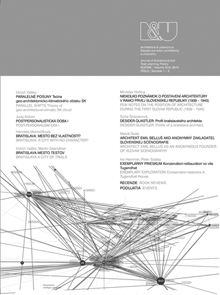Exemplárny prieskum. Konzervátori-reštaurátori vo vile Tugendhat
Exemplary exploration. Conservator-restorers in Tugendhat House
Author(s): Ivo Hammer, Peter SzalaySubject(s): Cultural Essay, Political Essay, Societal Essay
Published by: Historický ústav SAV, v. v. i.
Keywords: Restoration; conservation; materials; investigation; plaster; technology
Summary/Abstract: Brno, a city of many high-quality examples of modern movement architecture, boasts one of the iconic works of the period: the Tugendhat House by Ludwig Mies van der Rohe. The exceptional importance of this building rests not only in its often analysed aesthetic and historic assets, put also in its relatively well-preserved original state of the layout and surfaces in general. From this standpoint, Tugendhat House is one of the most authentic works by Mies van der Rohe in Europe. One of the main general objectives of restoration of architectural monuments as well as other works of art and artefacts is to preserve and present surface materials true to their original state. The substance of its architectural workmanship, material, colour and structure are documents of the time, and as such communicate the surface appearance but also traces of the history of these objects. In a figure of speech, the quest for the original intent of an architectural work is a kind of “archeological” exploration. The explorer must sift through the layers of history all the way to the initial stage of the building and discover the course of material transformation the subject had gone through. Compared to older works, monuments of modernist architecture appear to be much simpler in terms of deposits accumulated in the course of their existence. Their history, however, is more often than not just as complicated as those formed much earlier. Transformations during the 20th century left their renovation marks on Tugendhat House as well. The last and most important one in terms of house’s current shape had been undertaken during the first half of the 1980s. It was the first intervention since the completion of the house, aiming to renovate it with due respect to heritage protection and to restore it to its original shape. Despite material and political constraints of this restoration project, it can not be denied that it was a sensitive one, uncommon at the period even beyond the Iron Curtain. Nevertheless, the architects of today’s restoration of the house Tugendhat state that the layer of the eighties “had in itself no higher goal than to rehabilitate Mies’ work” and therefore it should to be eliminated. This restoration project had focused on one specific time period only: the time when Tugendhat family inhabited the building. Obviously it failed to foresee that present understanding of work’s original appearance is a subject to a contemporary taste just as well and hence future generations with new knowledge may re-evaluate it once again. As of January this year, the villa – a museum today, is closed to the public and the restoration work has been commenced. Prior to this rehabilitation, however, a lengthy process of reasoning took place in favour of a thorough scientific, conservatory and heritage-conscious approach to restoring the monument. During this period,several conferences, exhibitions and events were organized. The most important, impetus, however was there.
Journal: Architektúra & Urbanizmus
- Issue Year: 44/2010
- Issue No: 1-2
- Page Range: 150 - 161
- Page Count: 12
- Language: Slovak

